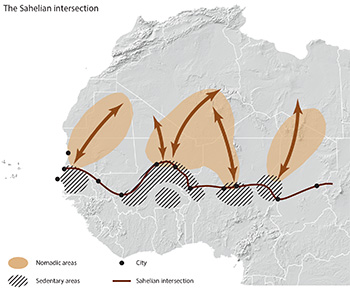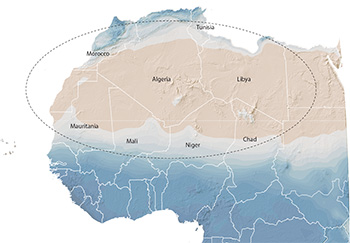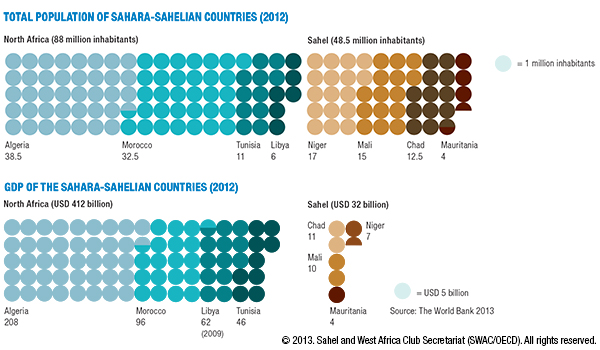West African Futures 2013-14: The Sahara-Sahelian areas
 |
The 2013-14 West African Futures (WAF) programme focuses on the Sahara-Sahel areas. The analysis highlights that mobility and fluidity have characterised the social and economic environment of the Sahara-Sahel over centuries. It also shows how actors, networks and challenges need to be considered from several geographic scales: from local, to cross-border and regional. It argues that these features, mobility and varying geographic scales should receive more attention in the short- and long- term security and development strategies for these areas shared by North, West and Central Africa. Stronger co-operation between these areas is a key factor to short- and long-term security and development. Initial results provided inputs for the SWAC Forum 2013. The SWAC Secretariat is currently preparing the launch of the Atlas of the Sahara-Sahel which proposes a new reading of the security-development challenges, based on a spatial and regional analysis. In partnership with a number of stakeholders, it has also positioned pastoral livestock, as a tool for stabilising and developing the region, and has provided inputs for a reflection on aid effectiveness. |
 |
|
|
The area studied encompasses Algeria, Chad, Libya, Mali, Mauritania, Morocco, Niger and Tunisia. It covers almost half of West Africa’s territory, 80% of the Maghreb and almost all of Mauritania. It shares a set of ancient civilisations united by a long tradition of trans-Saharan trade, and cultural and social exchange. The debates of the Forum highlighted that this area is increasingly connected to global networks of instability, requiring a broadening of the analyses to include countries of West, Central and North Africa.
|
 |
Forty years ago, drought put the Sahel in the spotlight of international attention. Emergency aid flowed in, creating the need to better understand the region to prevent future crises. Today, the Sahara-Sahelian region has yet again regained global attention, due to the insecurity threatening the area. The Sahel is perceived as a threat to the region’s states and against international security. The crisis in Mali in 2012-13, and frequently recurring manifestations of terrorist activity in the region, epitomise these risks and challenges. Long-term and multi-dimensional development solutions must be sought, built on collaboration and dialogue between North, West and Central Africa.
The following questions were addressed:
- Which responses fit which geographic scales in terms of stability of Sahara-Sahelian areas? What is the role of borders?
- What role do networks play in the development of mobility and how does mobility shape territories (structuring or destructuring)?
- Are the political dialogue and action mechanisms of the “Sahel strategies” and “security and development” initiatives in the region adapted (temporally, geographically and operationally) to current challenges?
- What is the political outlook for trans-Saharan co-operation? How should coherence of policies for sustainable peace be supported?
- How can economic relations between Sahara-Sahelian countries be strengthened?
- How can development co-operation in the Sahara-Sahel become more effective?
Sahel strategies & Documents
- European Union External Action Service (EEAS) Strategy for Security and Development in the Sahel, March 2011
- UN 2013 Sahel Regional Strategy, December 2012
- Progress towards the United Nations integrated strategy for the Sahel, 6 June 2014
- The African Union Strategy for the Sahel, 12 August 2014
- ECOWAS Strategy for the Sahel, 2014
- Mali: Strategy for the sustainable renewal of Mali 2013-2014, May 2013 (French)
- Niger: SDS-Sahel-Niger: Strategy for security and devlopment of the Sahara-Sahelian areas (French)
- USAID Sahel JPC Strategic Plan, 2012
- Final Declaration of the Elysee Summit on Peace and Security in Africa, 7 December 2013
Sahel-Sahara
- Sahara or Sahel? The Fuzzy Geography of Terrorism in West Africa, by O. Walther and D. Retaillé, November 2010
Boko Haram
- What is Boko Haram?, International Peace Institute, June 2012
- Curbing violence in Nigeria (II): the Boko Haram insurgency, International Crisis Group, April 2014
- Le Monde: Boko Haram news
- Decrypting Africa - Afrique decryptages - IFRI blog
- AfDB President Kaberuka blog on "Getting it right in the Sahel"
- AU Peance and Security Unit > http://www.peaceau.org
- European Union External Action - Sahel > http://eeas.europa.eu/crisis-response/where-we-work/sahel/index_en.htm
- UN Documents for Mali/Sahel > http://www.securitycouncilreport.org/un-documents/malisahel
- Sahel Intelligence : http://sahel-intelligence.com
- Institut Thomas More: Stabilising and rebuilding Mali - > subscribe to the bi-monthly newsletter
- IRIN presentation on the Sahel
- USAID - Sahel
- Sahel Research Group, Center for African Studies & Department of Political Science, University of Florida
High-level Meetings
- Security Council Discusses Situation in Sahel, 26 June 2013
- Security Council Discusses Situation in Sahel, 16 July 2013
- High-level Meeting Held on Sahel Region, 26 September 2013
- UN Secretary-General Addresses Ministerial Meeting on Sahel, 5 November 2013
- Regional Conference on Security in the Sahel, Rabat, 14 November 2013
Related Documents



